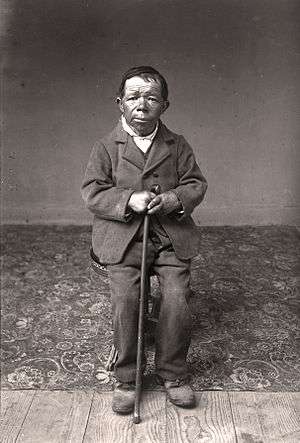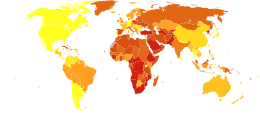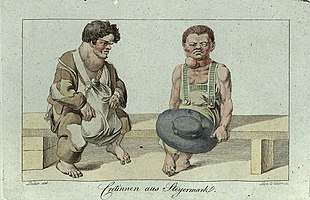Congenital iodine deficiency syndrome
Congenital iodine deficiency syndrome is a medical condition present at birth marked by impaired physical and mental development, due to insufficient thyroid hormone (hypothyroidism) due to insufficient iodine availability during pregnancy. It is one cause of underactivity of the thyroid gland at birth, called congenital hypothyroidism, and also referred to as cretinism.[1][2]
| Congenital iodine deficiency syndrome | |
|---|---|
| Other names | Cretinism |
 | |
| Portrait by Eugène Trutat of a man with congenital iodine deficiency syndrome | |
| Specialty | Endocrinology |
Signs and symptoms
Iodine deficiency causes gradual enlargement of the thyroid gland, referred to as a goiter. Poor length growth is apparent as early as the first year of life. Adult stature without treatment ranges from 100 to 160 cm (3 ft 3 in to 5 ft 3 in), depending on severity, sex, and other genetic factors. Other signs include thickened skin, hair loss, enlarged tongue, and a protruding abdomen[3] In children, bone maturation and puberty are severely delayed. In adults, ovulation is impeded and infertility is common.
Mental deterioration is common. Neurological impairment may be mild, with reduced muscle tone and coordination, or so severe that the person cannot stand or walk. Cognitive impairment may also range from mild to so severe that the person is nonverbal and dependent on others for basic care. Thought and reflexes are slower.
Cause

Around the world, the most common cause of congenital hypothyroidism is dietary iodine deficiency. It has affected many people worldwide and continues to be a major public health problem in many countries.
Iodine is an essential trace element, necessary for the synthesis of thyroid hormones. Iodine deficiency is the most common preventable cause of neonatal and childhood brain damage worldwide.[4] Although iodine is found in many foods, it is not universally present in all soils in adequate amounts. Most iodine, in iodide form, is in the oceans, where the iodide ions oxidize to elemental iodine, which then enters the atmosphere and falls to earth in rain, introducing iodine to soils. Earth deficient in iodine is most common inland and in mountainous areas and areas of frequent flooding, but can also occur in coastal regions owing to past glaciation, and leaching by snow, water and heavy rainfall, which removes iodine from the soil.[5] Plants and animals grown in iodine deficient soils are correspondingly deficient. Populations living in those areas without outside food sources are most at risk of iodine deficiency diseases.[6]
Differential diagnosis
Dwarfism may also be caused by malnutrition or other hormonal deficiencies, such as insufficient growth hormone secretion, hypopituitarism, decreased secretion of growth hormone-releasing hormone, deficient growth hormone receptor activity and downstream causes, such as insulin-like growth factor 1 (IGF-1) deficiency.
Prevention
There are public health campaigns in many countries which involve iodine administration.
Treatment
This type of congenital iodine deficiency has been almost completely eliminated in developed countries through early diagnosis by newborn screening schemes followed by lifelong treatment with thyroxine (T4).
Thyroxine must be dosed as tablets only, even to newborns, as the liquid oral suspensions and compounded forms cannot be depended on for reliable dosing. In the case of dosing infants, the T4 tablets are generally crushed and mixed with breast milk, formula milk or water. If the medication is mixed with formulas containing iron or soya products, larger doses may be required, as these substances may alter the absorption of thyroid hormone from the gut.[7] Monitoring TSH blood levels every 2–3 weeks during the first months of life is recommended to ensure that afflicted infants are at the high end of normal range.
Epidemiology
Congenital hypothyroidism can be endemic, genetic, or sporadic. If untreated, it results in mild to severe impairment of both physical and mental growth and development.
History

A goiter is the most specific clinical marker of either the direct or indirect insufficient intake of iodine in the human body. There is evidence of goiter, and its medical treatment with iodine-rich algae and burnt sponges, in Chinese, Egyptian, and Roman ancient medical texts. In 1848, King Carlo Alberto of Sardinia commissioned the first epidemiological study of congenital iodine deficiency syndrome, in northern Savoy where it was frequent. In past centuries, the well reported social diseases prevalent among the poorer social classes and farmers, caused by dietary and agricultural monocultures, were: pellagra, rickets, beriberi, scurvy in long-term sailors, and the endemic goiter caused by iodine deficiency. However, this disease was less mentioned in medical books because it was erroneously considered to be an aesthetic rather than a clinical disorder.[8]
Congenital iodine deficiency syndrome was especially common in areas of southern Europe around the Alps and was often described by ancient Roman writers and depicted by artists. The earliest Alpine mountain climbers sometimes came upon whole villages affected by it.[9] The prevalence of the condition was described from a medical perspective by several travellers and physicians in the late 18th and early 19th centuries.[10] At that time the cause was not known and it was often attributed to "stagnant air" in mountain valleys or "bad water". The proportion of people affected varied markedly throughout southern Europe and even within very small areas it might be common in one valley and not another. The number of severely affected persons was always a minority, and most persons were only affected to the extent of having a goitre and some degree of reduced cognition and growth. The majority of such cases were still socially functional in their pastoral villages.
More mildly affected areas of Europe and North America in the 19th century were referred to as "goitre belts". The degree of iodine deficiency was milder and manifested primarily as thyroid enlargement rather than severe mental and physical impairment. In Switzerland, for example, where soil does not contain a large amount of iodine, cases of congenital iodine deficiency syndrome were very abundant and even considered genetically caused. As the variety of food sources dramatically increased in Europe and North America and the populations became less completely dependent on locally grown food, the prevalence of endemic goitre diminished.
The early 20th century saw the discovery of the relationships of neurological impairment with hypothyroidism due to iodine deficiency. Both have been largely eliminated in the developed world.
Terminology
The term cretin was originally used to describe a person affected by this condition, but, as with words such as spastic and lunatic, it underwent pejoration and is now considered derogatory and inappropriate.[11] Cretin became a medical term in the 18th century, from an Occitan and an Alpine French expression, prevalent in a region where persons with such a condition were especially common (see below); it saw wide medical use in the 19th and early 20th centuries, and was a "tick box" category on Victorian-era census forms in the UK. The term spread more widely in popular English as a markedly derogatory term for a person who behaves stupidly. Because of its pejorative connotations in popular speech, health-care workers have mostly abandoned the term "cretin".
The etymology of cretin is uncertain. Several hypotheses exist. The most common derivation provided in English dictionaries is from the Alpine French dialect pronunciation of the word Chrétien ("(a) Christian"), which was a greeting there. According to the Oxford English Dictionary, the translation of the French term into "human creature" implies that the label "Christian" is a reminder of the humanity of the afflicted, in contrast to brute beasts.[12] Other sources suggest that Christian describes the person's "Christ-like" inability to sin, stemming, in such cases, from an incapacity to distinguish right from wrong.[13][14]
Other speculative etymologies have been offered:
References
- "Cretinism". merriam-webster.com. Merriam-Webster. Retrieved 5 October 2019.
a usually congenital condition marked by physical stunting and intellectual disability and caused by severe hypothyroidism
- William C. Shiel. "Medical Definition of Cretinism". medicinenet.com. MedicineNet. Retrieved 5 October 2019.
Cretinism: Congenital hypothyroidism (underactivity of the thyroid gland at birth), which results in growth retardation, developmental delay, and other abnormal features.
- Councilman, W. . (1913). "One". Disease and Its Causes. United States: New York Henry Holt and Company London Williams and Norgate The University Press, Cambridge, USA.
- Chen, Zu-Pei; Hetzel, BS (February 2010). "Cretinism Revisited". Clinical Endocrinology and Metabolism. 24 (1): 39–50. doi:10.1016/j.beem.2009.08.014. PMID 20172469.
- Chapter 20. The Iodine Deficiency Disorders Archived 2008-03-13 at the Wayback Machine Thyroid Disease Manager. Retrieved: 2011-06-26.
- Gaitan E, Dunn JT (1992). "Epidemiology of iodine deficiency". Trends Endocrinol. Metab. 3 (5): 170–5. doi:10.1016/1043-2760(92)90167-Y. PMID 18407097.
- Chorazy PA, Himelhoch S, Hopwood NJ, Greger NG, Postellon DC (July 1995). "Persistent hypothyroidism in an infant receiving a soy formula: case report and review of the literature". Pediatrics. 96 (1 Pt 1): 148–50. PMID 7596704.
- Venturi, Sebastiano (2014). "Iodine Deficiency in the Population of Montefeltro, A Territory in Central Italy Inside the Regions of Emilia-Romagna, Tuscany and Marche". International Journal of Anthropology. 29 (1–2): 1–12. Archived from the original on 2016-03-04. Retrieved 2015-11-02.
- Fergus Fleming, Killing Dragons: The Conquest of the Alps, 2000, Grove Press, p. 179
- See, for example, William Coxe, "Account of the Vallais, and of the Goiters and Idiots of that Country," Universal Magazine of Knowledge & Pleasure, vol. 67, Dec. 2, 1780.
- Taylor, Robert B. (2008). White Coat Tales: Medicine's Heroes, Heritage, and Misadventures. New York: Springer. p. 83. ISBN 978-0-387-73080-6.
- "cretin". Oxford English Dictionary. Retrieved 11 December 2005.
- Brockett, Linus P (Feb 1858). "Cretins And Idiots". The Atlantic Monthly. Retrieved 11 December 2005.
- Robbins and Cotran – Pathologic basis of disease 8/E. Philadelphia, PA: Sauders Elsevier. 2004.
- Medvei, VC (1993). The History of Clinical Endocrinology. Pearl River, New York: Parthenon Publishing Group.
External links
| Wikimedia Commons has media related to Congenital iodine deficiency syndrome. |
| Classification | |
|---|---|
| External resources |